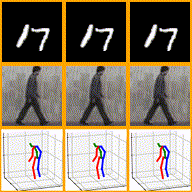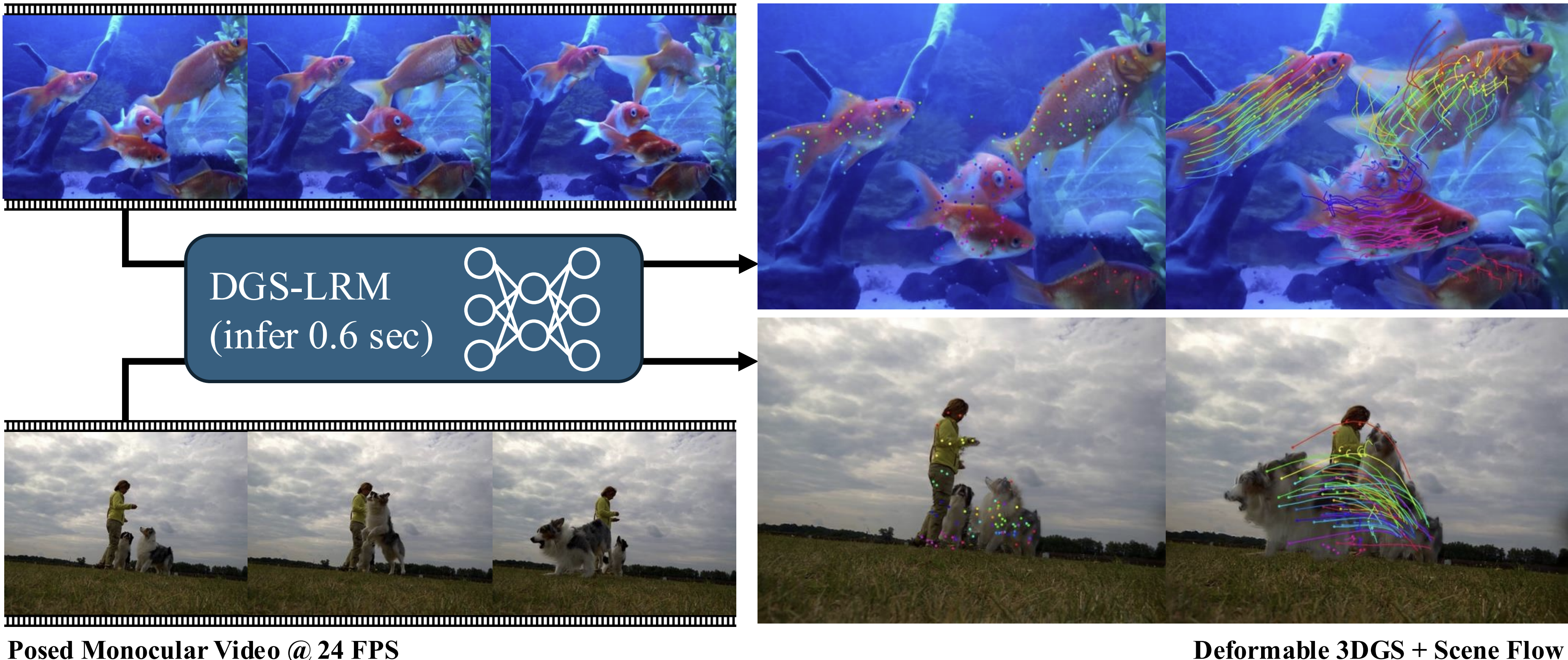 |
DGS-LRM: Real-Time Deformable 3D Gaussian Reconstruction From Monocular Videos
Chieh Hubert Lin, Zhaoyang Lv, Songyin Wu, Zhen Xu, Thu Nguyen-Phuoc, Hung-Yu Tseng, Julian Straub, Numair Khan, Lei Xiao, Ming-Hsuan Yang, Yuheng Ren, Richard Newcombe, Zhao Dong, Zhengqin Li
Arxiv
[abs]
[paper]
[project page]
We introduce the Deformable Gaussian Splats Large Reconstruction Model (DGS-LRM), the first feed-forward method predicting deformable
3D Gaussian splats from a monocular posed video of any dynamic scene. Feed-forward scene reconstruction has gained significant attention
for its ability to rapidly create digital replicas of real-world environments. However, most existing models are limited to static scenes
and fail to reconstruct the motion of moving objects. Developing a feed-forward model for dynamic scene reconstruction poses significant
challenges, including the scarcity of training data and the need for appropriate 3D representations and training paradigms. To address
these challenges, we introduce several key technical contributions: an enhanced large-scale synthetic dataset with ground-truth multi-view
videos and dense 3D scene flow supervision; a per-pixel deformable 3D Gaussian representation that is easy to learn, supports high-quality
dynamic view synthesis, and enables long-range 3D tracking; and a large transformer network that achieves real-time, generalizable dynamic
scene reconstruction. Extensive qualitative and quantitative experiments demonstrate that DGS-LRM achieves dynamic scene reconstruction
quality comparable to optimization-based methods, while significantly outperforming the state-of-the-art predictive dynamic reconstruction
method on real-world examples. Its predicted physically grounded 3D deformation is accurate and can readily adapt for long-range 3D tracking
tasks, achieving performance on par with state-of-the-art monocular video 3D tracking methods.
|
 |
Towards Affordance-Aware Articulation Synthesis for Rigged Objects
Yu-Chu Yu, Chieh Hubert Lin, Hsin-Ying Lee, Chaoyang Wang, Yu-Chiang Frank Wang, Ming-Hsuan Yang
Arxiv
[abs]
[paper]
[project page]
Rigged objects are commonly used in artist pipelines, as they can flexibly adapt to different
scenes and postures. However, articulating the rigs into realistic affordance-aware postures
(e.g., following the context, respecting the physics and the personalities of the object) remains
time-consuming and heavily relies on human labor from experienced artists. In this paper, we
tackle the novel problem and design A3Syn. With a given context, such as the environment mesh
and a text prompt of the desired posture, A3Syn synthesizes articulation parameters for arbitrary
and open-domain rigged objects obtained from the Internet. The task is incredibly challenging
due to the lack of training data, and we do not make any topological assumptions about the open-domain
rigs. We propose using 2D inpainting diffusion model and several control techniques to synthesize
in-context affordance information. Then, we develop an efficient bone correspondence alignment using
a combination of differentiable rendering and semantic correspondence. A3Syn has stable convergence,
completes in minutes, and synthesizes plausible affordance on different combinations of in-the-wild
object rigs and scenes.
|
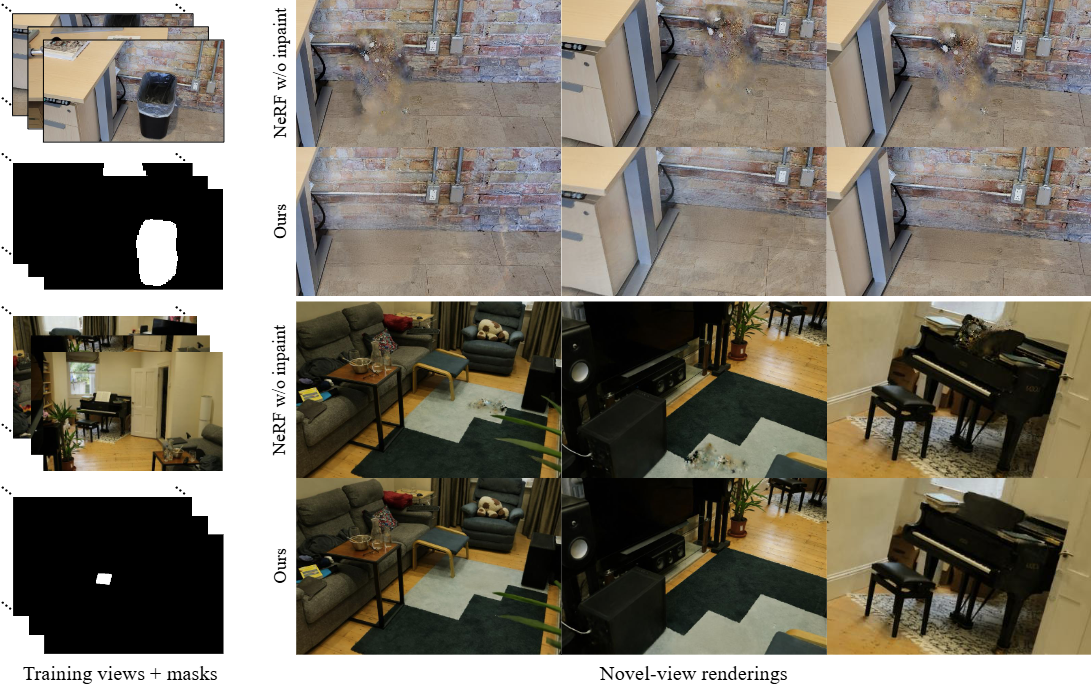 |
Taming Latent Diffusion Model for Neural Radiance Field Inpainting
Chieh Hubert Lin, Changil Kim, Jia-Bin Huang, Qinbo Li, Chih-Yao Ma, Johannes Kopf, Ming-Hsuan Yang, Hung-Yu Tseng
ECCV 2024
[abs]
[paper]
[project page]
Neural Radiance Field (NeRF) is a representation for 3D reconstruction from multi-view images.
Despite some recent work showing preliminary success in editing a reconstructed NeRF with
diffusion prior, they remain struggling to synthesize reasonable geometry in completely
uncovered regions. One major reason is the high diversity of synthetic contents from the
diffusion model, which hinders the radiance field from converging to a crisp and
deterministic geometry. Moreover, applying latent diffusion models on real data often
yields a textural shift incoherent to the image condition due to auto-encoding errors.
These two problems are further reinforced with the use of pixel-distance losses. To address
these issues, we propose tempering the diffusion model's stochasticity with per-scene
customization and mitigating the textural shift with masked adversarial training. During
the analyses, we also found the commonly used pixel and perceptual losses are harmful in the
NeRF inpainting task. Through rigorous experiments, our framework yields state-of-the-art NeRF
inpainting results on various real-world scenes.
|
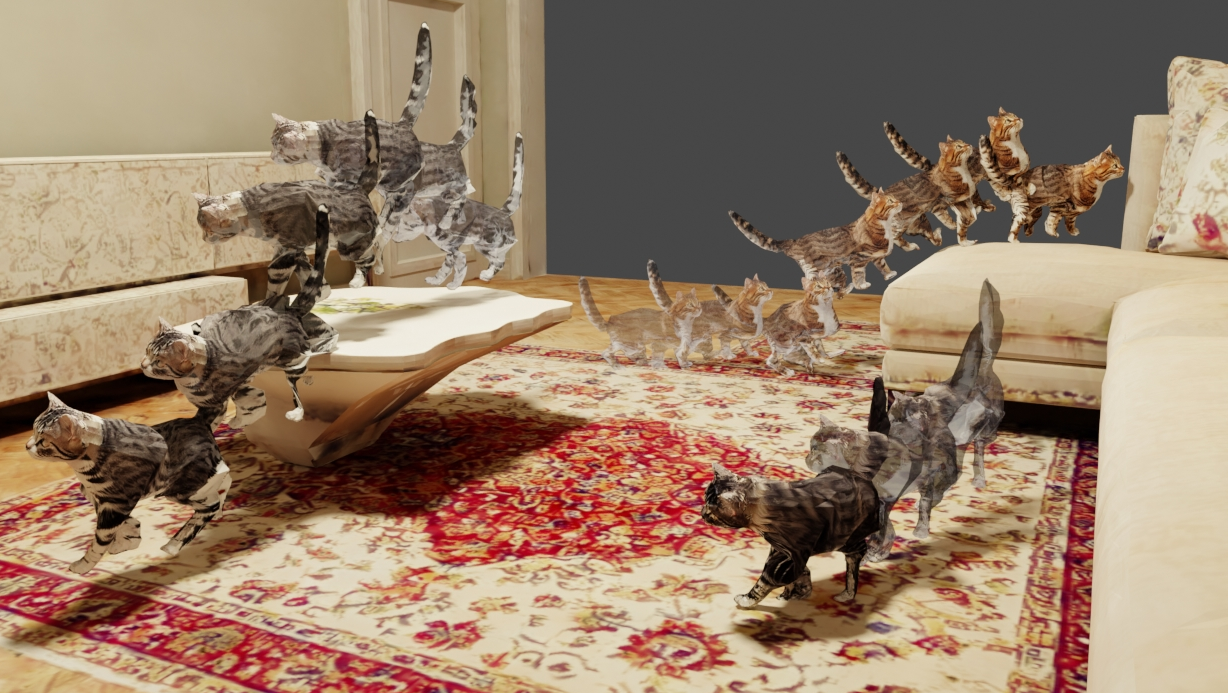 |
Virtual Pets: Animatable Animal Generation in 3D Scenes
Yen-Chi Cheng, Chieh Hubert Lin, Chaoyang Wang, Yash Kant, Sergey Tulyakov, Alexander Schwing, Liangyan Gui, Hsin-Ying Lee
ArXiv
[abs]
[paper]
[project page]
Toward unlocking the potential of generative models in immersive 4D experiences, we introduce
Virtual Pet, a novel pipeline to model realistic and diverse motions for target animal
species within a 3D environment. To circumvent the limited availability of 3D motion data
aligned with environmental geometry, we leverage monocular internet videos and extract
deformable NeRF representations for the foreground and static NeRF representations for
the background. For this, we develop a reconstruction strategy, encompassing species-level
shared template learning and per-video fine-tuning. Utilizing the reconstructed data,
we then train a conditional 3D motion model to learn the trajectory and articulation of
foreground animals in the context of 3D backgrounds. We showcase the efficacy of our
pipeline with comprehensive qualitative and quantitative evaluations using cat videos.
We also demonstrate versatility across unseen cats and indoor environments, producing
temporally coherent 4D outputs for enriched virtual experiences.
|
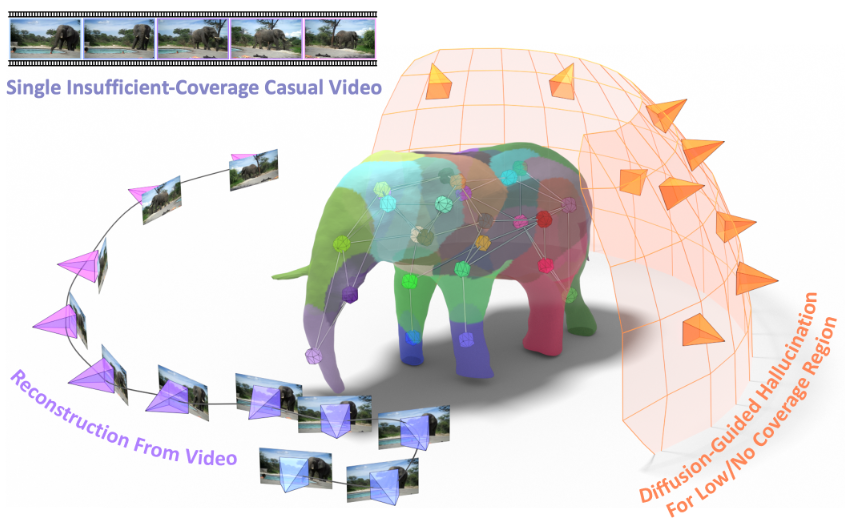 |
DreaMo: Articulated 3D Reconstruction From A Single Casual Video
Tao Tu, Ming-Feng Li, Chieh Hubert Lin, Yen-Chi Cheng, Min Sun, Ming-Hsuan Yang
WACV 2024
[abs]
[paper]
[project page]
Articulated 3D reconstruction has valuable applications in various domains, yet it remains costly and
demands intensive work from domain experts. Recent advancements in template-free learning methods
show promising results with monocular videos. Nevertheless, these approaches necessitate a
comprehensive coverage of all viewpoints of the subject in the input video, thus limiting their
applicability to casually captured videos from online sources. In this work, we study articulated
3D shape reconstruction from a single and casually captured internet video, where the subject's
view coverage is incomplete. We propose DreaMo that jointly performs shape reconstruction while
solving the challenging low-coverage regions with view-conditioned diffusion prior and several
tailored regularizations. In addition, we introduce a skeleton generation strategy to create
human-interpretable skeletons from the learned neural bones and skinning weights. We conduct
our study on a self-collected internet video collection characterized by incomplete view
coverage. DreaMo shows promising quality in novel-view rendering, detailed articulated shape
reconstruction, and skeleton generation. Extensive qualitative and quantitative studies validate
the efficacy of each proposed component, and show existing methods are unable to solve correct
geometry due to the incomplete view coverage.
|
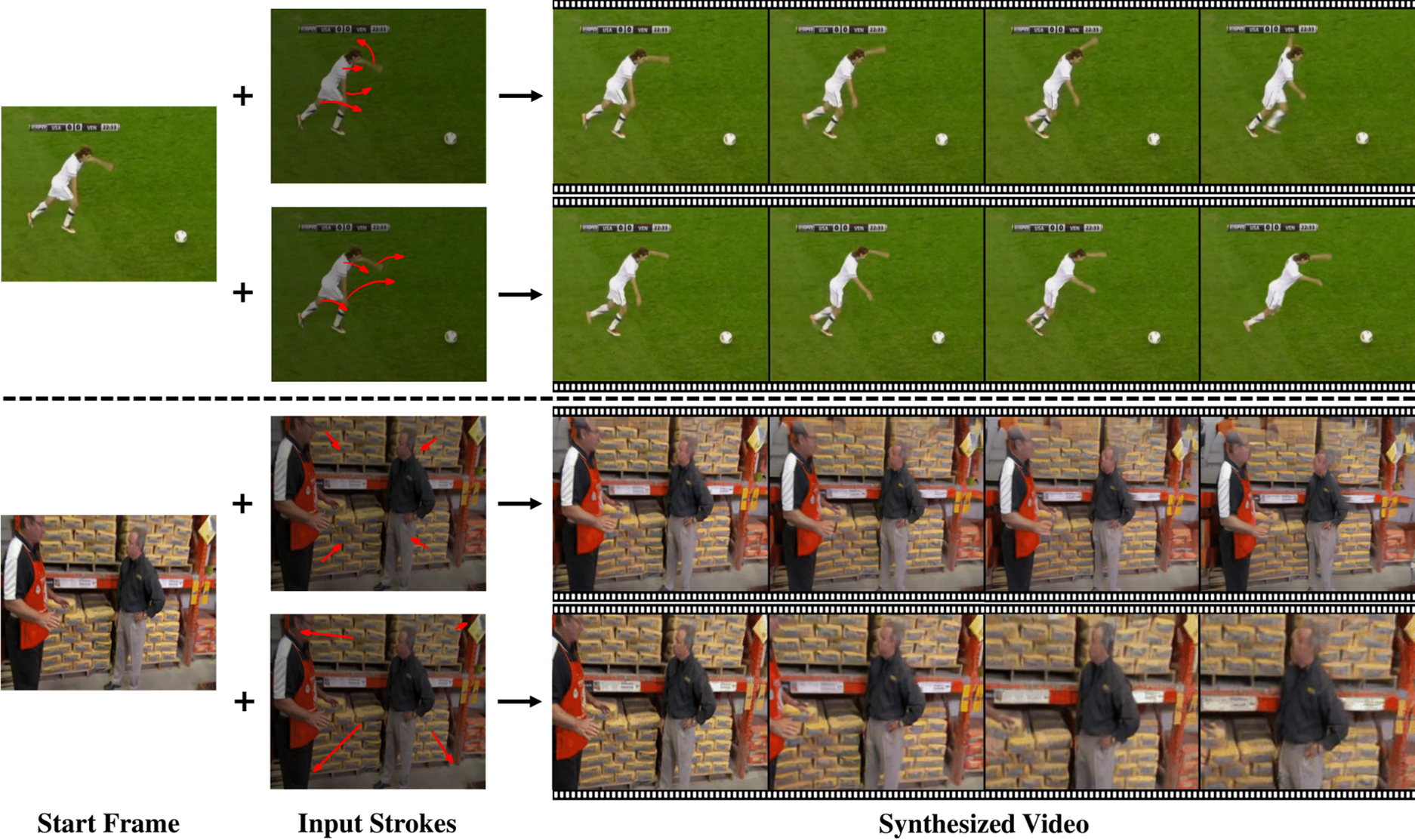 |
Motion-Conditioned Diffusion Model for Controllable Video Synthesis
Tsai-Shien Chen, Chieh Hubert Lin, Hung-Yu Tseng, Tsung-Yi Lin, Ming-Hsuan Yang
ArXiv
[abs]
[paper]
[project page]
Recent advancements in diffusion models have greatly improved the quality and diversity of synthesized
content. To harness the expressive power of diffusion models, researchers have explored various
controllable mechanisms that allow users to intuitively guide the content synthesis process.
Although the latest efforts have primarily focused on video synthesis, there has been a lack of
effective methods for controlling and describing desired content and motion. In response to this
gap, we introduce MCDiff, a conditional diffusion model that generates a video from a starting
image frame and a set of strokes, which allow users to specify the intended content and dynamics
for synthesis. To tackle the ambiguity of sparse motion inputs and achieve better synthesis
quality, MCDiff first utilizes a flow completion model to predict the dense video motion based
on the semantic understanding of the video frame and the sparse motion control. Then, the diffusion
model synthesizes high-quality future frames to form the output video. We qualitatively and
quantitatively show that MCDiff achieves the state-the-of-art visual quality in stroke-guided
controllable video synthesis. Additional experiments on MPII Human Pose further exhibit the
capability of our model on diverse content and motion synthesis.
|
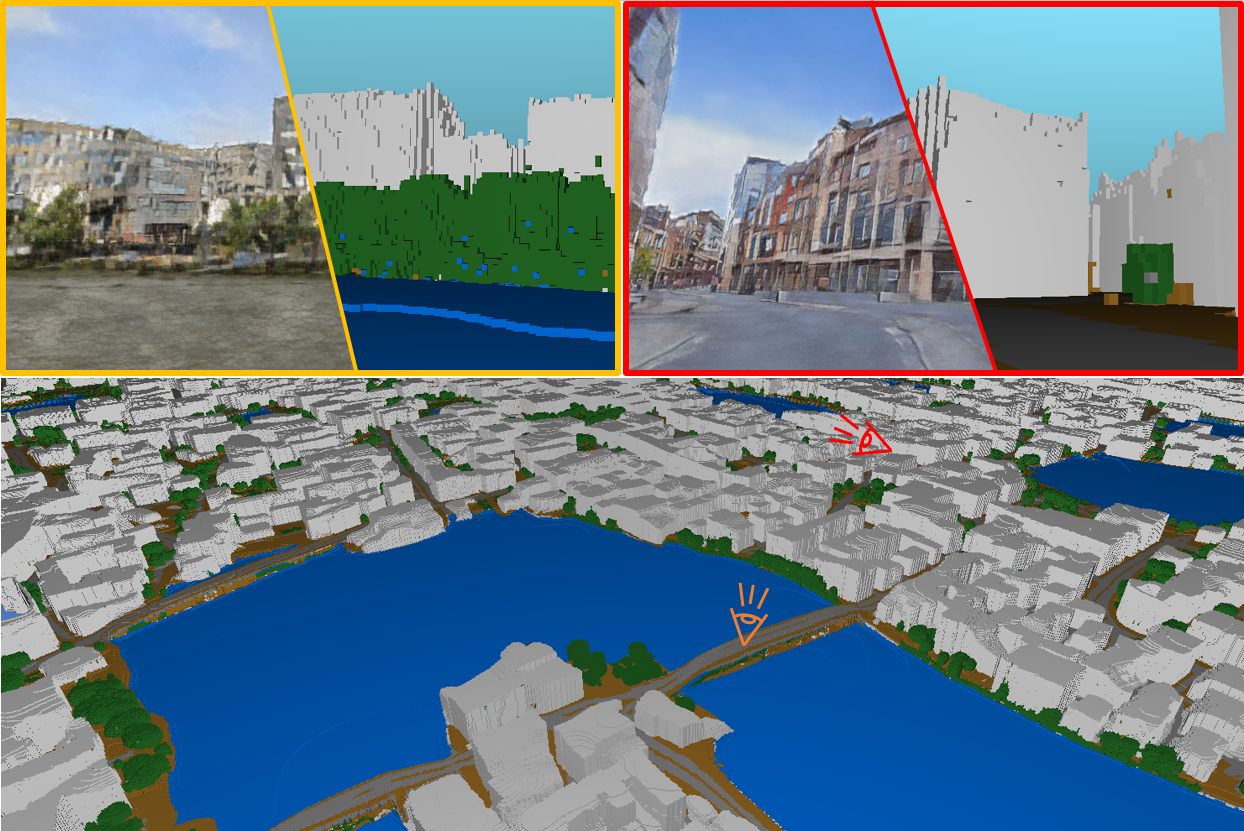 |
InfiniCity: Infinite-Scale City Synthesis
Chieh Hubert Lin, Hsin-Ying Lee, Willi Menapace, Menglei Chai, Aliaksandr Siarohin, Ming-Hsuan Yang, Sergey Tulyakov
ICCV 2023
[abs]
[paper]
[project page]
Toward infinite-scale 3D city synthesis, we propose a novel framework, InfiniCity,
which constructs and renders an unconstrainedly large and 3D-grounded environment from random noises.
InfiniCity decomposes the seemingly impractical task into three feasible modules, taking advantage of
both 2D and 3D data. First, an infinite-pixel image synthesis module generates arbitrary-scale 2D maps
from the bird's-eye view. Next, an octree-based voxel completion module lifts the generated 2D map to
3D octrees. Finally, a voxel-based neural rendering module texturizes the voxels and renders 2D images.
InfiniCity can thus synthesize arbitrary-scale and traversable 3D city environments, and allow flexible
and interactive editing from users. We quantitatively and qualitatively demonstrate the efficacy of the
proposed framework.
|
 |
Unveiling The Mask of Position-Information Pattern Through the Mist of Image Features
Chieh Hubert Lin, Hsin-Ying Lee, Hung-Yu Tseng, Maneesh Singh, Ming-Hsuan Yang
ICML 2023
[abs]
[paper]
Recent studies have shown that paddings in convolutional neural networks encode
absolute position information which can negatively affect the model performance
for certain tasks. However, existing metrics for quantifying the strength of
positional information remain unreliable and frequently lead to erroneous results.
To address this issue, we propose novel metrics for measuring and visualizing
the encoded positional information. We formally define the encoded information
as Position-information Pattern from Padding (PPP) and conduct a series of
experiments to study its properties as well as its formation. The proposed metrics
measure the presence of positional information more reliably than the existing
metrics based on PosENet and tests in F-Conv. We also demonstrate that for any
extant (and proposed) padding schemes, PPP is primarily a learning artifact and is
less dependent on the characteristics of the underlying padding schemes.
|
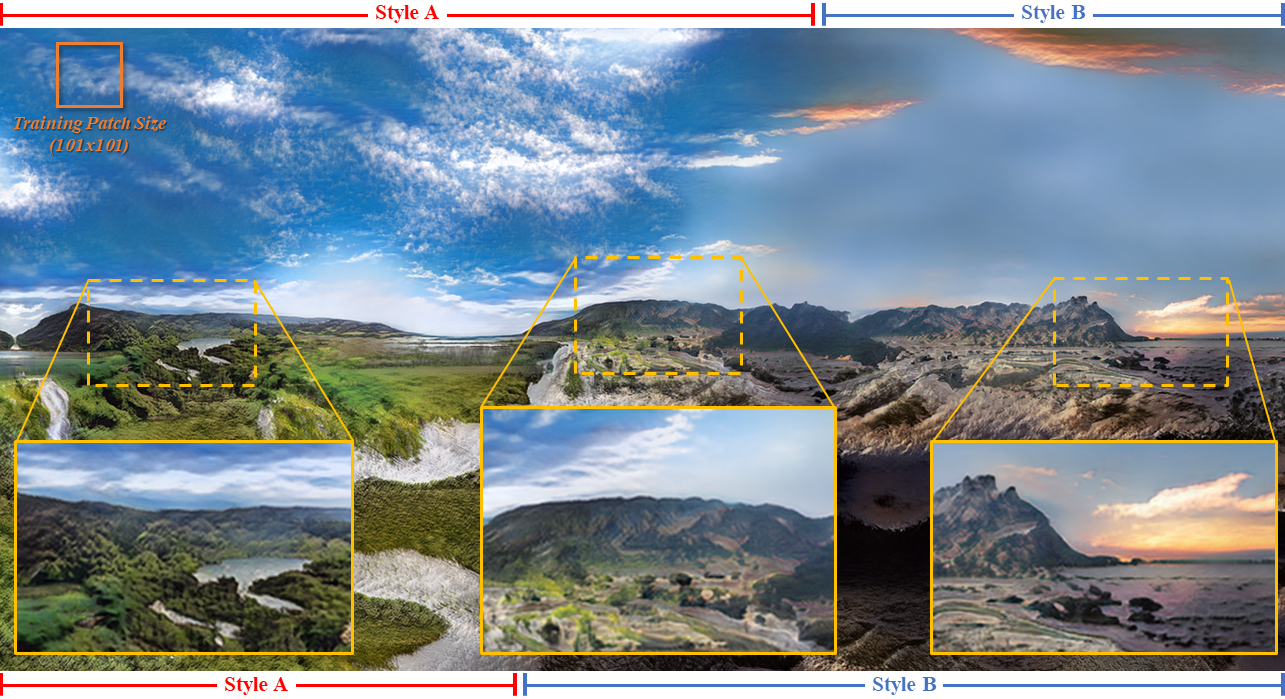 |
InfinityGAN: Towards Infinite-Pixel Image Synthesis
Chieh Hubert Lin, Hsin-Ying Lee, Yen-Chi Cheng, Sergey Tulyakov, Ming-Hsuan Yang
ICLR 2022
[abs]
[paper]
[project page]
[codes (PyTorch)]
We present InfinityGAN, a method to generate arbitrary-sized images. The problem is associated with several key
challenges. First, scaling existing models to an arbitrarily large image size is resource-constrained, both in terms
of computation and availability of large-field-of-view training data. InfinityGAN trains and infers patch-by-patch
seamlessly with low computational resources. Second, large images should be locally and globally consistent, avoid
repetitive patterns, and look realistic. To address these, InfinityGAN takes global appearance, local structure and
texture into account. With this formulation, we can generate images with spatial size and level of detail not attainable
before. Experimental evaluation supports that InfinityGAN generates images with superior global structure compared to
baselines and features parallelizable inference. Finally, we show several applications unlocked by our approach, such as
fusing styles spatially, multi-modal outpainting and image inbetweening at arbitrary input and output sizes.
|
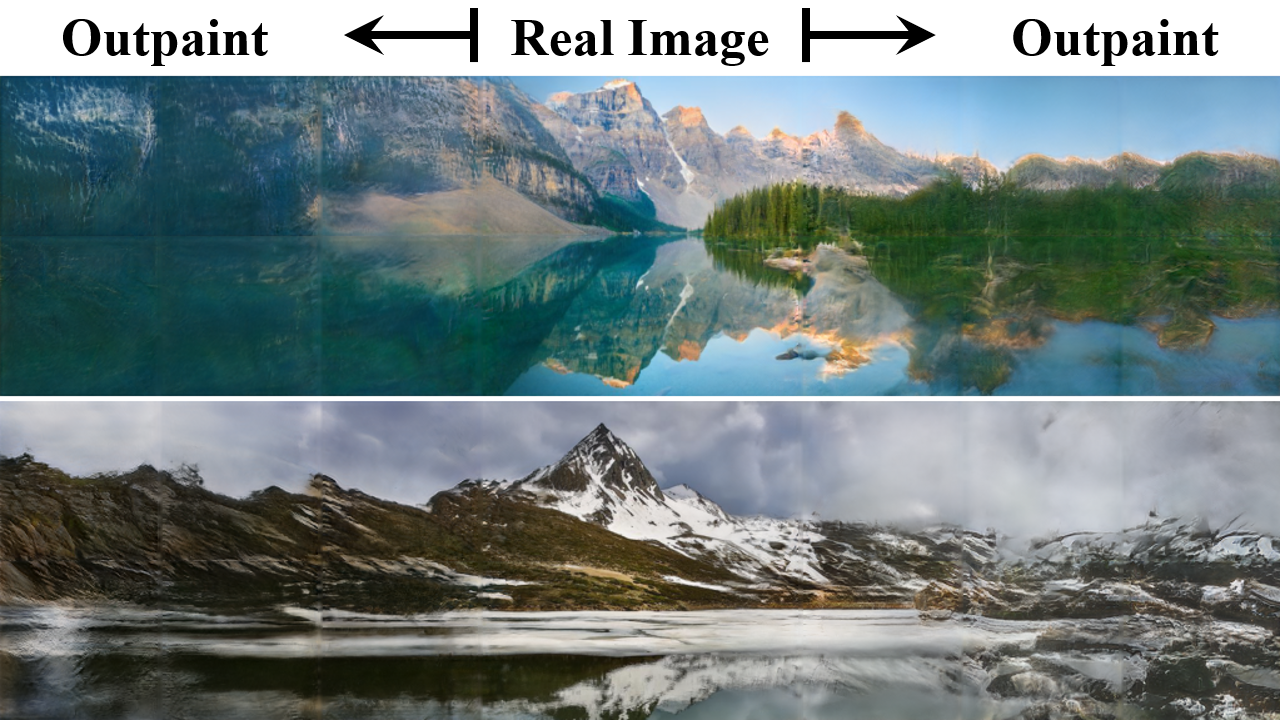 |
In&Out : Diverse Image Outpainting via GAN Inversion
Yen-Chi Cheng, Chieh Hubert Lin, Hsin-Ying Lee, Jian Ren, Sergey Tulyakov, Ming-Hsuan Yang
CVPR 2022
[abs]
[paper]
[project page]
[codes (TBA)]
Image outpainting seeks for a semantically consistent extension of the input image beyond its available content.
Compared to inpainting -- filling in missing pixels in a way coherent with the neighboring pixels -- outpainting
can be achieved in more diverse ways since the problem is less constrained by the surrounding pixels. Existing
image outpainting methods pose the problem as a conditional image-to-image translation task, often generating
repetitive structures and textures by replicating the content available in the input image. In this work, we formulate
the problem from the perspective of inverting generative adversarial networks. Our generator renders micro-patches
conditioned on their joint latent code as well as their individual positions in the image. To outpaint an image, we
seek for multiple latent codes not only recovering available patches but also synthesizing diverse outpainting by
patch-based generation. This leads to richer structure and content in the outpainted regions. Furthermore, our
formulation allows for outpainting conditioned on the categorical input, thereby enabling flexible user controls.
Extensive experimental results demonstrate the proposed method performs favorably against existing in- and outpainting
methods, featuring higher visual quality and diversity.
|
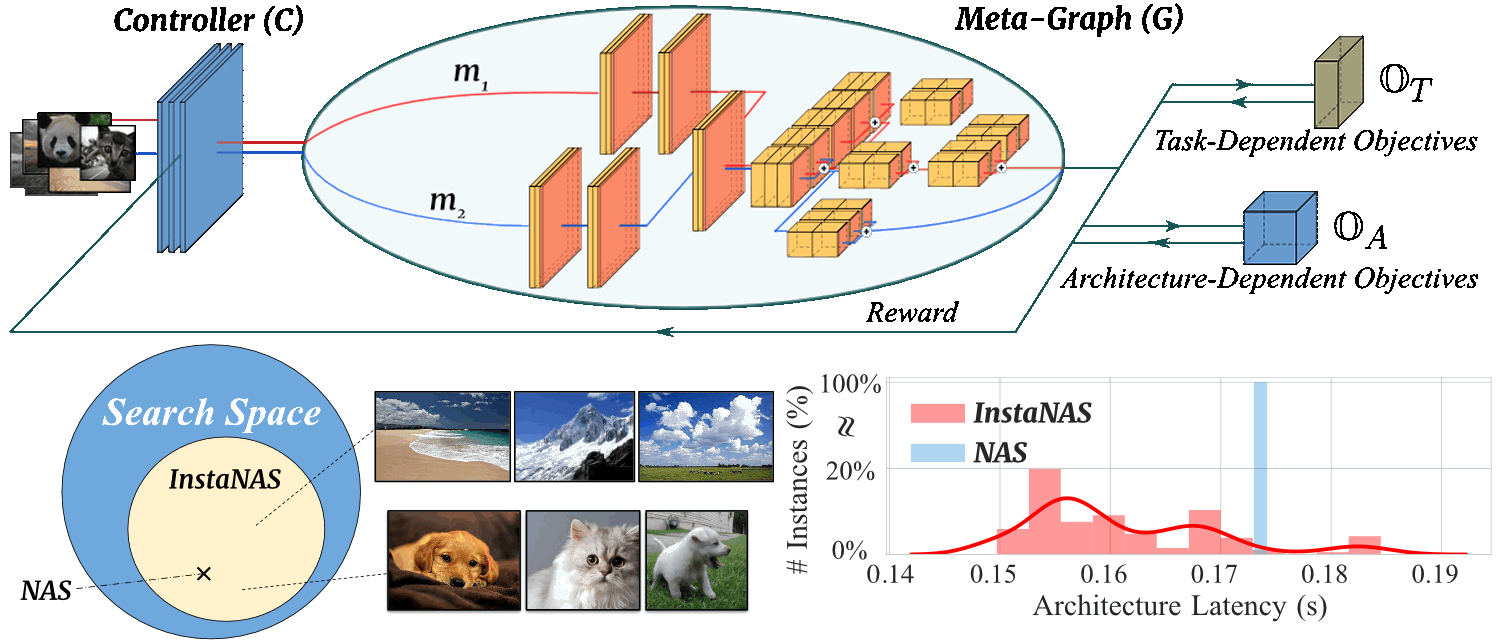 |
InstaNAS: Instance-aware Neural Architecture Search
An-Chieh Cheng*, Chieh Hubert Lin*, Da-Cheng Juan, Wei Wei, Min Sun
AAAI 2020
[abs]
[paper]
[project page (w/ demo)]
[codes]
Conventional Neural Architecture Search (NAS) aims at finding a single architecture that
achieves the best performance, which usually optimizes task related learning objectives such
as accuracy. However, a single architecture may not be representative enough for the whole
dataset with high diversity and variety. Intuitively, electing domain-expert architectures
that are proficient in domain-specific features can further benefit architecture related
objectives such as latency. In this paper, we propose InstaNAS---an instance-aware NAS
framework---that employs a controller trained to search for a "distribution of architectures"
instead of a single architecture; This allows the model to use sophisticated architectures
for the difficult samples, which usually comes with large architecture related cost, and
shallow architectures for those easy samples. During the inference phase, the controller
assigns each of the unseen input samples with a domain expert architecture that can achieve
high accuracy with customized inference costs. Experiments within a search space inspired by
MobileNetV2 show InstaNAS can achieve up to 48.8% latency reduction without compromising
accuracy on a series of datasets against MobileNetV2.
|
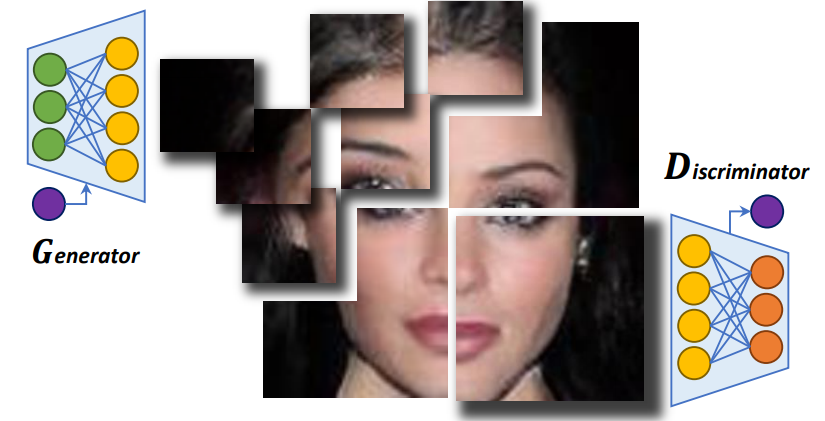 |
COCO-GAN: Generation by Parts via Conditional Coordinating
Chieh Hubert Lin, Chia-Che Chang, Yu-Sheng Chen, Da-Cheng Juan, Wei Wei, Hwann-Tzong Chen
ICCV 2019 (oral)
[abs]
[paper (low resolution)]
[paper (high resolution)]
[project page]
[codes]
Humans can only interact with part of the surrounding environment due to biological restrictions.
Therefore, we learn to reason the spatial relationships across a series of observations to piece
together the surrounding environment. Inspired by such behavior and the fact that machines also have
computational constraints, we propose COnditional COordinate GAN (COCO-GAN)
of which the generator generates images by parts based on their spatial coordinates as the condition.
On the other hand, the discriminator learns to justify realism across multiple assembled patches by
global coherence, local appearance, and edge-crossing continuity. Despite the full images are never
generated during training, we show that COCO-GAN can produce \textbf{state-of-the-art-quality}
full images during inference. We further demonstrate a variety of novel applications enabled by
teaching the network to be aware of coordinates. First, we perform extrapolation to the learned
coordinate manifold and generate off-the-boundary patches. Combining with the originally generated
full image, COCO-GAN can produce images that are larger than training samples, which we called
"beyond-boundary generation". We then showcase panorama generation within a cylindrical coordinate
system that inherently preserves horizontally cyclic topology. On the computation side, COCO-GAN
has a built-in divide-and-conquer paradigm that reduces memory requisition during training and
inference, provides high-parallelism, and can generate parts of images on-demand.
|
|
|
Point-to-Point Video Generation
Tsun-Hsuan Wang*, Yen-Chi Cheng*, Chieh Hubert Lin, Hwann-Tzong Chen, Min Sun
ICCV 2019
[abs]
[paper]
[project page]
[codes]
While image manipulation achieves tremendous breakthroughs (e.g., generating realistic faces) in
recent years, video generation is much less explored and harder to control, which limits its applications
in the real world. For instance, video editing requires temporal coherence across multiple clips and
thus poses both start and end constraints within a video sequence. We introduce point-to-point video
generation that controls the generation process with two control points: the targeted start- and end-frames.
The task is challenging since the model not only generates a smooth transition of frames, but also
plans ahead to ensure that the generated end-frame conforms to the targeted end-frame for videos of
various length. We propose to maximize the modified variational lower bound of conditional data
likelihood under a skip-frame training strategy. Our model can generate sequences such that their
end-frame is consistent with the targeted end-frame without loss of quality and diversity. Extensive
experiments are conducted on Stochastic Moving MNIST, Weizmann Human Action, and Human3.6M to evaluate
the effectiveness of the proposed method. We demonstrate our method under a series of scenarios
(e.g., dynamic length generation) and the qualitative results showcase the potential and merits of
point-to-point generation.
|
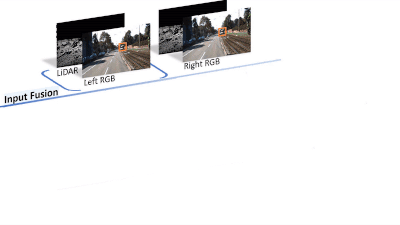 |
3D LiDAR and Stereo Fusion using Stereo Matching Network with Conditional Cost Volume Normalization
Tsun-Hsuan Wang, Hou-Ning Hu, Chieh Hubert Lin, Yi-Hsuan Tsai, Wei-Chen Chiu, Min Sun
IROS 2019
[abs]
[paper]
[project page]
[codes]
The complementary characteristics of active and passive depth sensing techniques motivate the
fusion of the Li-DAR sensor and stereo camera for improved depth perception. Instead of directly
fusing estimated depths across LiDAR and stereo modalities, we take advantages of the stereo
matching network with two enhanced techniques: Input Fusion and Conditional Cost Volume
Normalization (CCVNorm) on the LiDAR information. The proposed framework is generic and closely
integrated with the cost volume component that is commonly utilized in stereo matching neural networks.
We experimentally verify the efficacy and robustness of our method on the KITTI Stereo and Depth
Completion datasets, obtaining favorable performance against various fusion strategies. Moreover,
we demonstrate that, with a hierarchical extension of CCVNorm, the proposed method brings only slight
overhead to the stereo matching network in terms of computation time and model size.
|
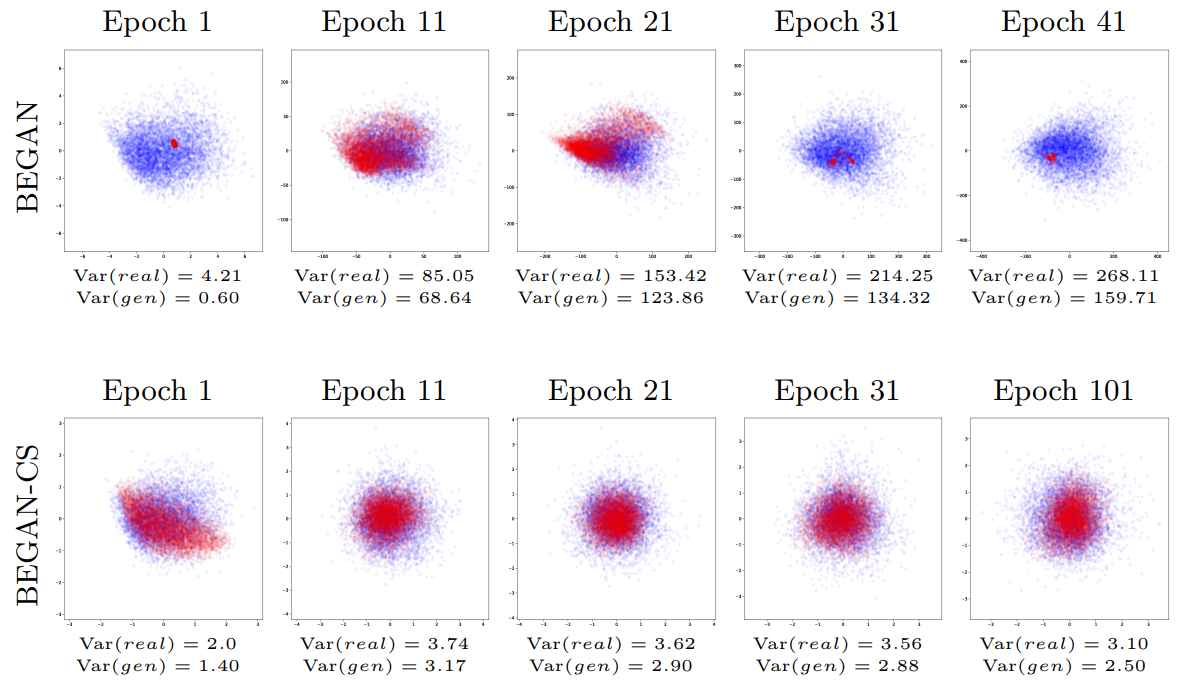 |
Escaping from Collapsing Modes in a Constrained Space
Chia-Che Chang*, Chieh Hubert Lin*, Che-Rung Lee, Da-Cheng Juan, Wei Wei, Hwann-Tzong Chen
ECCV 2018
[abs]
[paper]
[codes]
Generative adversarial networks (GANs) often suffer from unpredictable mode-collapsing during training.
We study the issue of mode collapse of Boundary Equilibrium Generative Adversarial Network (BEGAN),
which is one of the state-of-the-art generative models. Despite its potential of generating high-quality images,
we find that BEGAN tends to collapse at some modes after a period of training. We propose a new model,
called BEGAN with a Constrained Space (BEGAN-CS), which includes a latent-space constraint in the
loss function. We show that BEGAN-CS can significantly improve training stability and suppress mode collapse
without either increasing the model complexity or degrading the image quality. Further, we visualize the distribution
of latent vectors to elucidate the effect of latent-space constraint. The experimental results show that our method has
additional advantages of being able to train on small datasets and to generate images similar to a given real
image yet with variations of designated attributes on-the-fly.
|













